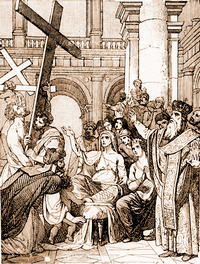Lives of the Saints
Our Models and Protectors
Spiritual Bouquet:
May 3

The Finding
of the Holy Cross
(326)
When God restored peace to His Church by exalting Constantine the Great to the imperial throne, that pious prince, who had triumphed over his enemies by the miraculous power of the Cross of Christ, was very desirous of expressing his veneration for the holy places which had been honored and sanctified by the presence and sufferings of our blessed Redeemer on earth. He accordingly resolved to build a magnificent church in the city of Jerusalem.
Saint Helen, the Emperor's mother, desiring to visit the holy places there, made a journey into Palestine in 326, though she was at that time near eighty years of age. On her arrival at Jerusalem she was inspired with a great desire to find the identical cross on which Christ had suffered for our sins, in order to build the proposed church on the site of Calvary. But there was no mark or tradition, even among the Christians, to show where it might lie. Saint Helen consulted everyone in Jerusalem and the surrounding areas, whom she thought likely to assist her in discovering the cross. She was credibly informed that, if she could find the holy sepulchre, she would also find the instruments of the punishment, since it was the custom among the Jews to dig a pit near the place where the body of a criminal was buried, and to throw into it whatever had contributed to his execution.
The Roman pagans who were dominated by an aversion to Christianity had done what they could to conceal the place where our Saviour was buried by heaping on it a great quantity of stone and rubbish, and building there a temple to Venus. They had also erected a statue of Jupiter in the place where Our Lord rose from the dead. The pious Empress therefore ordered the profane buildings to be pulled down, the statue broken in pieces, and the rubbish removed. And then, upon digging to a great depth, the holy sepulchre was uncovered.
Near it were found three crosses and the nails which had pierced Our Saviour's body, with the title which had been fixed to His cross. By this discovery they knew that one of those three crosses was the one they sought, and that the others belonged to the two criminals between whom Our Saviour had been crucified. But because the title was found separate from the cross, it was difficult to distinguish which of the three crosses was the one on which our Redeemer consummated His sacrifice for the salvation of the world. In this perplexity the holy Bishop of Jerusalem Macarius, knowing that one of the principal ladies of the city lay ill and at the point of death, suggested to the Empress to have the three crosses carried to the sick person, not doubting that God would reveal which one was the cross they sought. Saint Macarius prayed that God would have regard to their faith, and then he applied the crosses, one after another, to the patient. She was immediately and perfectly cured by the touch of the True Cross, after the others had been tried without effect.
Saint Helen, full of joy at having found the treasure which she had so earnestly sought and so highly esteemed, built a church on the site and placed the cross there with great veneration, after providing for it an extraordinarily rich silver reliquary. She afterwards carried part of it to her son Constantine at Constantinople, who received it with great veneration; and another part she took to Rome, to be placed in the church which she built there, called Church of the Holy Cross of Jerusalem, where it remains to this day.
The title was sent by Saint Helen to that church in Rome, and placed on the top of an arch, where it was found in a case of lead in 1492. The inscription in Hebrew, Greek, and Latin is in red letters, and the wood was whitened. So it was in 1492; but these colors have since faded, and the words Jesus and Judaeorum are eaten away. The board is nine inches long, but is considered to have measured about twelve originally.
The reliquary of Jerusalem was committed to the care of Saint Macarius and kept with singular care and respect in the magnificent church which Saint Helen and her son built there. Saint Paulinus relates that, though chips were almost daily cut off from it and given to devout persons, yet the sacred wood suffered thereby no diminution. It is affirmed by Saint Cyril of Jerusalem, twenty-five years after the discovery, that pieces of the cross were spread all over the earth; he compares this wonder to the miraculous feeding of five thousand men, as recorded in the Gospel. The discovery of the cross would have happened in the spring, after navigation began on the Mediterranean Sea, for Saint Helen went the same year to Constantinople and from there to Rome, where she died in the arms of her son on the 18th of August of the same year, 326.
Reflection. In all pious undertakings, above all in the sanctification of the soul, the mere beginning does not suffice. Whoever perseveres to the end, he shall be saved. (Matt. 24:13)
Les Petits Bollandistes: Vies des Saints, by Msgr. Paul Guérin (Bloud et Barral: Paris, 1882), Vol. 5; Little Pictorial Lives of the Saints, a compilation based on Butler's Lives of the Saints and other sources by John Gilmary Shea (Benziger Brothers: New York, 1894)